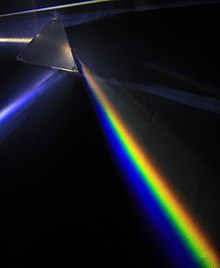Espektroskopya
Ang espektroskopya ay ang pag-aaral ng interaksyon sa pagitan ng materya at electromagnetic radiyasyon bilang function na nakadepende sa wavelength o dalasan ng radiation.[1][2][3][4][5] Sa mas pinasimpleng mga salita, ang espektroskopya ay ang tiyak na pangkalahatang pag-aaral ng kulay mula sa visible light hanggang sa lahat ng mga bands ng electromagnetic spectrum ; sa katunayan, sa kasaysayan, ang espektroskopya ay nagsimula bilang pag-aaral ng wavelength dependence ng absorption ng gas phase matter ng visible light na pinaghiwa-hiwalay ng isang prism . Ang mga matter wave at acoustic wave ay maaari ding ituring na mga anyo ng radiative energy, at kamakailan lamang, ang mga alon ng grabitasyon ay iniugnay sa isang spectral signature sa konteksto ng Laser Interferometer Gravitational-Wave Observatory (LIGO).

Mga sanggunian
baguhin- ↑ H. W. Kroto, Molecular Rotation Spectra, Wiley, New York, 1975 (Reprinted by Dover 1992)
- ↑ Philip R. Bunker and Per Jensen, Molecular Symmetry and Spectroscopy, NRC Research Press, Ottawa, 1998 ISBN 9780660196282
- ↑ D. Papoušek and M. R. Aliev, Molecular Vibrational-Rotational Spectra Elsevier, Amsterdam, 1982
- ↑ E. B. Wilson, J. C. Decius, and P. C. Cross, Molecular Vibrations, McGraw-Hill, New York, 1955 (Reprinted by Dover 1980)
- ↑ Herrmann, R.; C. Onkelinx (1986). "Quantities and units in clinical chemistry: Nebulizer and flame properties in flame emission and absorption spectrometry (Recommendations 1986)". Pure and Applied Chemistry. 58 (12): 1737–1742. doi:10.1351/pac198658121737.
{{cite journal}}: CS1 maint: date auto-translated (link)